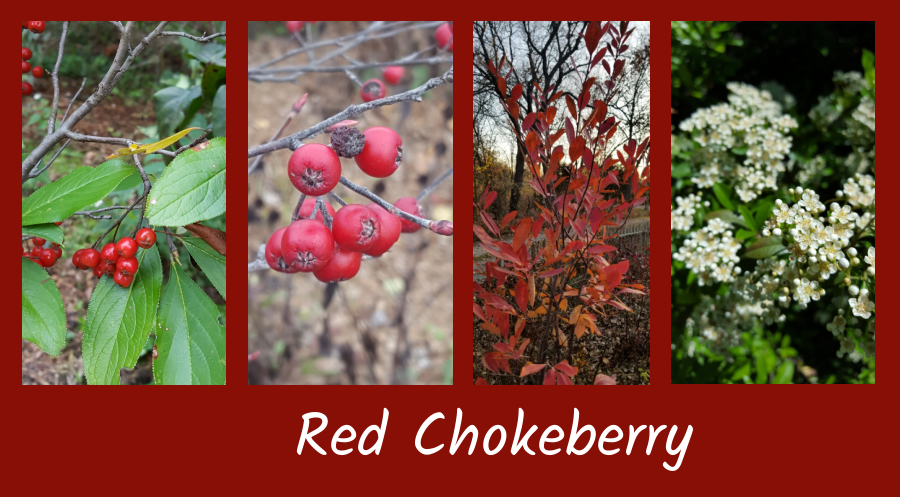Aronia is our 2023 April Plant of the Month. One of the most versatile North American native shrubs; there are 3 species, 2 of which are used commercially in the U.S. Besides being a very useful landscape plant, Aronia berries are considered a superfood. I have always loved the multiple season interest of these shrubs, plus the edibility.
Native to the Eastern half of the United States, Aronia grows in a variety of habitats. Red chokeberry, Aronia arbutifolia can be found from Texas to Maine, along the eastern seaboard. Black chokeberry, Aronia melanocarpa, is found primarily in the Northeastern and the upper Midwest regions. Purple chokeberry, Aronia prunifolia grows in almost the same areas as black chokeberry.
Red Chokeberry
Even though the berries on this shrub are not as used as black chokeberry, they are edible, but tart and bitter. Berries can be used for jellies, jam, tarts, and juice. Red chokeberry grows 6 to 15 feet tall by 3 to 6 feet wide. It is vase shaped, and can be used as a specimen in the landscape. One of the things I love the most about this shrub is its fall color. The leaves are deep red, and combined with the berries, it has great ornamental value.
In April, flowers are white with a blush of pink. Pollinators include honeybees, bumblebees, bee flies, and early flying butterflies. The berries add winter interest as birds rarely go for them. Japanese beetles can be a problem; in 2021 they consumed one of my whole plants before I caught their work!

Black Chokeberry
I absolutely love this plant! Since it is one of the best landscape shrubs, I have used it in many places. And it is tolerant of high pH soils, making it a great plant for most landscape situations. I have even used it in tough, wet spots in landscape beds. Black chokeberry grows anywhere from 1 to 12 feet tall by 3 to 12 feet wide, depending on cultivar. One of the more unusual things about it is that many of our cultivars come from Northern Europe, where the plant was taken after discovery in the early 1800s.
But because we have all this cultivation work already done for us, we get to reap the benefits of the plant’s versatility. One of the more recent introductions have been the short, dwarf varieties which are great for groundcovers in full sun. The leaves are shiny green, turning shades of red and orange in autumn.
The berries are the star of the show. They are dark purple to deep black-blue, and hang in large clusters on the plants. However, they are too astringent to be eaten raw. I would describe at eating a cotton ball. But, you can use the berries for jelly, jam, pie, wine, and juice. And they are rarely eaten by birds, so they last all winter long.

Cultivars of Aronia
Using aronia in the garden is not hard. They prefer full sun in moist to well-drained soils. Also, pH is not an issue, as they are adaptable to high pH soils, and prefer to be in the range of 5.5 to 6.5. While the red chokeberry does have an issue with Japanese beetles, black chokeberry rarely does. I have seen some damage, but they mostly leave it alone for other plants.
- ‘Autumn Magic’ – one of the best landscape cultivars, it grows 3 to 5 feet tall and wide. It is hardy in Zones 4 to 7. I love it because of its great fall color.
- ‘Ground Hug’ – one of the newest cultivars, it makes a great groundcover plant. It grows 1 foot tall by 3 feet wide and literally hugs the ground. There is no needed maintenance for this plant! It is hardy in Zones 4 to 9.
- ‘Low Scape Mound’ – another new variety, it grows 2 feet tall and wide. Its a great plant for the front of the garden, just behind the border, and is hardy in Zones 3 to 9.
- ‘Viking’ – one of our European cultivars, this variety grows 8 feet tall by 6 feet wide. It is hardy in Zones 3 to 8.
- ‘Brilliant Red’ – this is our best cultivar of red chokeberry. It grows 9 feet tall and 8 feet wide and it is hardy in Zones 5 to 8.
Conclusion
Aronia is also known as chokeberry, and is very rich in antioxidants. The flowers are early bloomers, and they attract early bees and butterflies. A great plant for the landscape, aronia can fit into so many spots. And now that we have so many new cultivars, everyone can grow it.
Happy planting!




